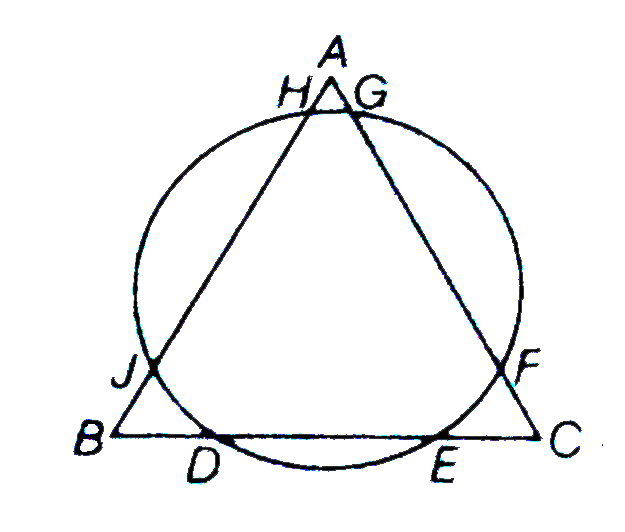In an equilateral triangle, three coins of radii 1 unit each are kept so that they touch each other and also the sides of the triangle. The area of the triangle is 2sqrt(3)(b)6+4sqrt(3)12+(7sqrt(3))/4(d)3+(7sqrt(3))/4
(4+2√3)cm2
14(12+7√3)cm2
14(48+7√3)cm2
(6+4√3)cm2
The correct Answer is:D
Step by step video solution for In an equilateral triangle, three coins of radii 1 unit each are kept so that they touch each other and also the sides of the triangle. The area of the triangle is 2sqrt(3) (b) 6+4sqrt(3) 12+(7sqrt(3))/4 (d) 3+(7sqrt(3))/4 by Maths experts to help you in doubts & scoring excellent marks in Class 12 exams.
Updated on:21/07/2023Topper's Solved these Questions
- PROPERTIES AND SOLUTION OF TRIANGLES BOOK - ARIHANT MATHS ENGLISHCHAPTER - PROPERTIES AND SOLUTION OF TRIANGLES EXERCISE - Exercise (More Than One Correct Option Type Questions)
23 Videos
- PROPERTIES AND SOLUTION OF TRIANGLES BOOK - ARIHANT MATHS ENGLISHCHAPTER - PROPERTIES AND SOLUTION OF TRIANGLES EXERCISE - Exercise (Statement I And Ii Type Questions)
11 Videos
- PROPERTIES AND SOLUTION OF TRIANGLES BOOK - ARIHANT MATHS ENGLISHCHAPTER - PROPERTIES AND SOLUTION OF TRIANGLES EXERCISE - PROPERTIES AND SOLUTIONS OF TRIANGLES EXERSISE 1: SINGLE OPTION CORRECT TYPE QUESTIONS
1 Video
- PRODUCT OF VECTORSBOOK - ARIHANT MATHS ENGLISHCHAPTER - PRODUCT OF VECTORSEXERCISE - Exercise (Questions Asked In Previous 13 Years Exam)
51 Videos
- SEQUENCES AND SERIESBOOK - ARIHANT MATHS ENGLISHCHAPTER - SEQUENCES AND SERIESEXERCISE - Exercise (Questions Asked In Previous 13 Years Exam)
38 Videos
Similar Questions
If area of ΔABC(Δ) and angle C are given and if c opposite to given angle is minimum, then
View SolutionIn a triangle ABC,a3+b3+c3=c2(a+b+c) (All symbol used have usual meaning in a triangle.) Statement-1: The value of ∠C=60∘. Statement-2: ΔABC must be equilateral.
View SolutionIn the adjoining figure, the circle meets the sides of an equilateral triangle at six points.

If AG=2,GF=13,FC=1andHJ=7, then DE equals to
View SolutionLet O be the origin and let PQR be an arbitrary triangle. The point S is such that ¯¯¯¯¯¯OP⋅¯¯¯¯¯¯OQ+¯¯¯¯¯¯OR⋅¯¯¯¯¯¯OS=¯¯¯¯¯¯OR⋅¯¯¯¯¯¯OP+¯¯¯¯¯¯OQ⋅¯¯¯¯¯¯OS=¯¯¯¯¯¯OQ⋅¯¯¯¯¯¯OR+¯¯¯¯¯¯OP⋅¯¯¯¯¯¯OS Then the triangle PQR has S as its
View SolutionLet a,b,c be in A.P. and |a|<1,|b|<1|c|<1.ifx=1+a+a2+....to ∞,y=1+b+b2+....to ∞and,z=1+c+c2+...to ∞, then x,y,z are in
View SolutionIn an equilateral triangle, three coins of radii 1 unit each are kept so that they touch each other and also the sides of the triangle. The area of the triangle is (fig) 4:2√3 (b) 6+4√3 12+7√34 (d) 3+7√34
View SolutionOne angle of an isosceles triangle is 1200 and the radius of its incircle is √3. Then the area of the triangle in sq. units is
(a) 7+12√3 (b) 12−7√3 (c) 12+7√3 (d) 4π
View SolutionIn an equilateral triangle,3 coins of radii 1 unit each are kept so each other and also the side of the triangle.the area of the triangle is:
View SolutionIn an equilateral triangle, three coins of radii 1 unit each are kept so that they touch each other and also the sides of the triangle. The area of the triangle ABC is
View SolutionThe area of an equilateral triangle is 4√3 cm2. The length of each of its side is (a)3 cm (b) 4 cm (c)2√3 cm (d) √32 cm
View SolutionEach side of an equilateral triangle is equal to the radius of a circle whose area is 154 cm2. The area of the triangle is (a)7√34 cm2 (b) 49√32 cm2 (c)49√34 cm2 (d) 7√32 cm2
View Solution4√3−7√12+2√75=
View SolutionIn an equilateral triangle 3 coins of radii 1 unit each are kept so that they touch each other and also the sides of the triangle. Are of the triangle is- 4+2√3 b. 6+4√3 c. 12+7√34 d. 3+7√34
View SolutionIn an equilateral triangle, three identical coins of radii 1 units each, are kept so that they touch each other and also the sides of a triangle. Find the area of the triangle.
View SolutionThe area of an equilateral triangle is 4√3cm2. Then the of each of the sides of the triangle is
View SolutionIf the sides of an equilateral triangle be increased by 2 cm each, the area of the triangle is increased by 2√3cm2. Determine the length of each sides of the equilateral triangle.
View Solution

